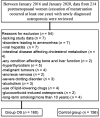Association of dyslipidaemia with osteoporosis in postmenopausal women
- PMID: 33775162
- PMCID: PMC8010835
- DOI: 10.1177/0300060521999555
Association of dyslipidaemia with osteoporosis in postmenopausal women
Abstract
Objective: To assess the association of dyslipidaemia with osteoporosis in postmenopausal women.
Methods: Data from 160 postmenopausal women with newly diagnosed osteoporosis (osteoporosis group) and 156 healthy controls (control group) were retrospectively reviewed from 2016 to 2020. The primary outcomes were laboratory values assessed by a multivariate binary logistic regression model.
Results: Factors that greatly increased the risk of being in the osteoporosis group included high low-density lipoprotein (LDL) and low high-density lipoprotein (HDL) levels. The osteoporosis group had lower HDL and higher LDL levels than the control group. A multivariate binary logistic regression model showed that lower HDL and higher LDL levels were the only variables that were significantly associated with osteoporosis (odds ratio 1.86, 95% confidence interval: 3.66-4.25 and odds ratio 1.47, 95% confidence interval: 1.25-2.74, respectively).
Conclusion: Low HDL and high LDL levels may be associated with the occurrence of osteoporosis in postmenopausal women.
Keywords: Dyslipidaemia; bone mineral density; cholesterol; diabetes; high-density lipoprotein; low-density lipoprotein; osteoporosis.
Conflict of interest statement
Figures
Similar articles
-
Association of dyslipidaemia with Alzheimer's disease in a cohort of postmenopausal women.J Int Med Res. 2020 Jun;48(6):300060520926020. doi: 10.1177/0300060520926020. J Int Med Res. 2020. PMID: 32567449 Free PMC article.
-
HDL cholesterol and bone mineral density in normal-weight postmenopausal women: is there any possible association?Panminerva Med. 2008 Jun;50(2):89-96. Panminerva Med. 2008. PMID: 18607332
-
Serum lipid levels and bone mineral density in Greek postmenopausal women.Gynecol Endocrinol. 2012 Aug;28(8):655-60. doi: 10.3109/09513590.2011.650766. Epub 2012 Feb 10. Gynecol Endocrinol. 2012. PMID: 22324476
-
Plasma lipids and osteoporosis in postmenopausal women.Endocr J. 2002 Apr;49(2):211-7. doi: 10.1507/endocrj.49.211. Endocr J. 2002. PMID: 12081241
-
Dyslipidaemia for patients with low-energy femoral neck fractures after the treatment of cancellous screws: a retrospective study with a 3-year minimum follow-up.BMC Musculoskelet Disord. 2017 Nov 10;18(1):440. doi: 10.1186/s12891-017-1804-x. BMC Musculoskelet Disord. 2017. PMID: 29126401 Free PMC article.
Cited by
-
Liver-bone crosstalk in non-alcoholic fatty liver disease: Clinical implications and underlying pathophysiology.Front Endocrinol (Lausanne). 2023 Mar 10;14:1161402. doi: 10.3389/fendo.2023.1161402. eCollection 2023. Front Endocrinol (Lausanne). 2023. PMID: 36967758 Free PMC article. Review.
-
Correlation between serum high-density lipoprotein cholesterol and bone mineral density in vitamin D-deficient populations.J Bone Miner Metab. 2025 Mar;43(2):174-181. doi: 10.1007/s00774-024-01572-w. Epub 2025 Jan 15. J Bone Miner Metab. 2025. PMID: 39814987
-
Hypnotics and injuries among older adults with Parkinson's disease: a nested case-control design.BMC Geriatr. 2023 May 1;23(1):259. doi: 10.1186/s12877-023-03944-9. BMC Geriatr. 2023. PMID: 37127561 Free PMC article.
-
Inverse association between low-density lipoprotein cholesterol and bone mineral density in young- and middle-aged people: The NHANES 2011-2018.Front Med (Lausanne). 2022 Aug 10;9:929709. doi: 10.3389/fmed.2022.929709. eCollection 2022. Front Med (Lausanne). 2022. PMID: 36035390 Free PMC article.
-
IL-6 and Leptin Are Potential Biomarkers for Osteoporotic Fracture Risk Assessment and Prediction of Postmenopausal Women with Low Bone Mass: A Follow-Up Study Using a Regional Sample Cohort.Oxid Med Cell Longev. 2022 Aug 10;2022:8691830. doi: 10.1155/2022/8691830. eCollection 2022. Oxid Med Cell Longev. 2022. PMID: 35993023 Free PMC article.
References
-
- Matsubara T, Ikeda F, Hata K, et al.. Cbp Recruitment of Csk into Lipid Rafts Is Critical to c-Src Kinase Activity and Bone Resorption in Osteoclasts. J Bone Miner Res 2010; 25: 1068–1076. - PubMed
-
- Ongphiphadhanakul B, Chanprasertyothin S, Chailurkit L, et al.. Differential associations of residual estradiol levels with bone mineral density and serum lipids in postmenopausal women with osteoporosis. Maturitas 2004; 48: 193–196. - PubMed
-
- Ozgocmen S, Kaya H, Fadillioglu E, et al.. Role of antioxidant systems, lipid peroxidation, and nitric oxide in postmenopausal osteoporosis. Mol Cell Biochem 2007; 295: 45–52. - PubMed
-
- Parhami F, Garfinkel A, Demer LL. Role of lipids in osteoporosis. Arterioscler Thromb Vasc Biol 2000; 20: 2346–2348. - PubMed
-
- Mori H, Okada Y, Kishikawa H, et al.. Effects of raloxifene on lipid and bone metabolism in postmenopausal women with type 2 diabetes. J Bone Miner Metab 2013; 31: 89–95. - PubMed
MeSH terms
Substances
LinkOut - more resources
Full Text Sources
Other Literature Sources
Medical


